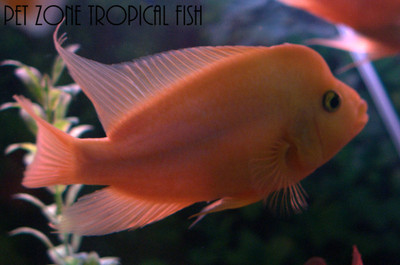The Red Devil Cichlid: A Fascinating Aquatic Marvel
Posted by Max Gandara on on 24th Aug 2023
The realm of freshwater aquariums is teeming with a diverse array of
captivating fish species, each with its unique characteristics and
charm. Among these, the Red Devil Cichlid (Amphilophus labiatus) stands
out as a remarkable and iconic species that has captured the hearts of
aquarium enthusiasts for decades. Known for its vibrant colors,
distinctive behavior, and intriguing social dynamics, the Red Devil
Cichlid has become a popular choice for experienced hobbyists and
novices alike.
The Red Devil Cichlid boasts a striking appearance, characterized by its
fiery red-orange coloration. Its intense hue sets it apart from many
other fish species and serves as a visual centerpiece in aquarium
setups. Adult Red Devil Cichlids exhibit a robust and streamlined body,
which tapers towards the caudal fin. Their eyes are large and
expressive, adding to their distinctive look.
Native to Central America, particularly Nicaragua and Costa Rica, the
Red Devil Cichlid primarily inhabits slow-moving rivers, lakes, and
ponds with a preference for areas with ample hiding spots such as
submerged tree roots and aquatic vegetation. Their natural habitat gives
insights into their preferences in captivity.
One of the most captivating aspects of the Red Devil Cichlid is its
behavior. These fish are known for their highly territorial and
aggressive nature, especially during the breeding season. They are aptly
named "Red Devils" due to their tendency to exhibit fierce and
combative behavior when protecting their territory or offspring. While
their aggression might make them unsuitable for community tanks, it also
adds to their charm for hobbyists looking to keep a unique and engaging
species.
Creating a suitable environment for Red Devil Cichlids requires careful
consideration. Given their territorial nature, it's advisable to provide
a spacious tank with plenty of hiding spots and visual barriers. A tank
of at least 75 gallons is recommended for a single specimen. Substrate
should be soft and sandy, mimicking their natural habitat.
Red Devil Cichlids are omnivores, and their diet should reflect this. A
balanced diet includes high-quality pellets, flakes, live or frozen
foods such as bloodworms, brine shrimp, and even occasional treats like
chopped vegetables or fruits. Providing a varied diet ensures their
nutritional needs are met.
Breeding Red Devil Cichlids can be a rewarding yet challenging endeavor.
During the breeding season, males establish territories and work
diligently to attract a female. Successful pairs engage in elaborate
courtship rituals, after which the female lays eggs on a flat substrate
or surface. The male vigorously guards the eggs and fry, displaying the
protective behavior that gives the species its reputation.
The Red Devil Cichlid's unique combination of vibrant coloration,
complex behavior, and intense social dynamics makes it a captivating
addition to the world of freshwater aquariums. While its territorial
nature might not make it suitable for every aquarist, those willing to
dedicate the time and effort to understand and care for these remarkable
fish are rewarded with a fascinating aquatic companion that truly
stands out. As with any fish species, responsible ownership, adequate
research, and proper care are paramount to ensuring the health and
well-being of the Red Devil Cichlid in captivity.

